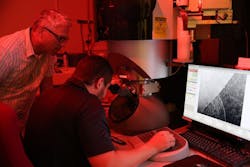“Marine grade” stainless steel is valued for its ability to stave off corrosion and its high ductility (the ability to bend without breaking under stress), making it a preferred choice for oil pipelines, welding, ships, kitchen utensils, chemical equipment, medical implants, engine parts, and nuclear waste storage. However, conventional techniques for strengthening marine steel typically come at the expense of ductility.
Lawrence Livermore National Laboratory (LLNL) researchers found a way to make marine steel via 3D printing. Their new method, already proven to work for one of the most common forms of marine grade stainless steel—low-carbon 316L—could lead to new combinations of high ductility and strength for the ubiquitous alloy.
“We were able to 3D print real components in the lab with 316L stainless steel, and the material’s performance was actually better than those made with the traditional approach,” says LLNL materials scientist and lead author Morris Wang. “That’s really a big jump. It makes additive manufacturing very attractive and fills a major gap.”
Wang said the new approach could open the floodgates to widespread 3D printing of stainless steel components—particularly in the aerospace, automotive, and oil and gas industries, where strong, tough materials must withstand extreme forces in harsh environments.
To come up with this improved version of 316L steel, researchers first had to overcome a major problem for 3D printing metals: porosity created during laser melting (or fusion) of metal powders, which can lead to parts degrading or fracturing easily. Researchers addressed this by varying the material’s density until they came up with the best using computer modeling, as well as by manipulating the materials’ underlying microstructure.
Using two different laser powder bed fusion machines, researchers printed thin plates of 316L steel for mechanical testing. The laser melting technique inherently resulted in hierarchical cell-like structures that could be tuned to alter the mechanical properties. The team discovered that when you additively manufacture 316L, it creates an interesting grain structure: The grains are not small, but the cellular structures and other defects inside of them are commonly seen in welding, and seem to be controlling the properties. This research could provide new insights into the structure-property relationships of additively manufactured materials.
Thin plates of 3D-printed 316L steel were tested for both strength and ductility.
Deformation in metals is mainly controlled by how nanoscale defects move and interact in the microstructure. The cellular structure in the printed metal acts a filter, letting some defects move freely, and thus provide ductility, while blocking some others to provide strength. Observing these mechanisms and understanding their complexity could allow engineers to uncover new ways to control the mechanical properties of 3D-printed materials.
The eventual goal is to use high-performance computing to validate and predict future performance of stainless steels, employing models to control the underlying microstructure and discover how to make high-performance steels, including the corrosion resistance. Researchers will then look at employing a similar strategy with other lighter-weight alloys that are more brittle and prone to cracking.
The work took several years and required the contributions of the Ames Lab, which did X-ray diffraction to understand material performance; Georgia Tech, which performed modeling to understand how the material could have high strength and high ductility; and Oregon State, which performed characterization and composition analysis.



